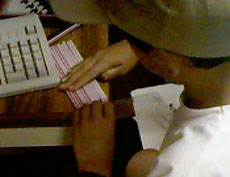|
July 10, 1997 The fourth day of Shodor's Internet Explorers Club began with a review of the previous day's material, concentrating primarily on the importance of not trusting everything you are exposed to. With this and other old material fresh on their minds, the Explorers set out to learn new and interesting things about computers and science through computational modeling. The day began with Tom Dietz, an intern at the Foundation, who continued yesterday's work on computational modeling. Looking primarily at the Population Dynamics Model and the Flu Epidemic Model, many students were able to move on to an offsite model of volcanic eruptions. Although the modeling was certainly exciting, the Shodor staff stressed the importance of understanding a model's strengths and limitations. In discussing the population model, the students were asked to consider factors, not calculated by the model, that affect changes in population. Nicole, an Internet Explorers Club student, explained that rapid population growth can be expected since "we have better protection from diseases and things like that." Other more serious factors discussed included an investigation of Germany's economic system and political past. Because of Germany's industrialized state, the birth rate could be expected to be much lower than a primarily agrarian economy. Also, with the unification of the former East and West Germany, new factors have arisen in the nation's development. Still, these factors only touched the surface of what was affecting the population model's chosen birth and death rate variables. In concluding their investigation of the Population Dynamics model, the students decided that a society's technologies and a population's health were the primary factors determining population growth Concluding their investigation of the models, the students moved on to another demonstration from Dr. Robert Panoff, a.k.a. Bob1. Similar to yesterday's activity, the emphasis of the presentation was to prove that you should not always rely on what something "says." To demonstrate this point, Bob1 handed out boxes containing everyday drinking straws. Each box claimed to contain fifty straws, each with a certain standardized diameter. After carefully counting and measuring the straws in each box, the students concluded that the number of straws in a box may be fifty, but any particular box can contain up to fifty-two straws. In the same way, it was concluded that the diameter of a straw was also inconsistent with the box's label.
"Can you trust anything you see on the box now?" asked Bob1. Continuing with his presentation, Bob1 stated, "the point is you're not getting what you're told you're getting." As if that were not enough to establish his point, several students noticed that the boxes claimed the straws were "squash proof." Then Bob1 brought up a new point: "what does squash proof mean?" "If you had to rely on their information to build a straw, you wouldn't be able to rely on that information," explained Bob1, emphasizing the fact that the information was inconsistent with itself. Furthermore, in the instance of medicine, a slight difference in an important specification can mean the even more important difference between life and death. The result of the demonstration was a sucessful transfer of a singal idea; refusing to trust or assume anything when dealing with science unless the information can truly be said to be a fact wihout any doubt. Jonathan Pahl, yet another of Shodor's interns, then introduced the IEC students to an Ebola model he has helped develop for this program. Again, the students concentrated on the factors that affected an ebola-susceptible population, not to mention the infected population. After completing a pictorial representation of the model's variables on the board, the students were asked to consider what additional pieces of information they would need to run the model. Once this was determined, the students were sent onto the Internet to find the necessary data. After ten minutes of searching, the students collaborated with one another to calculate the proper numbers for the model. Again, using what they had learned, the students selected the data which seemed the most promising. Although they were unable to run the model today, the Internet Explorer's look forward to the opportunity of exploring the model in tomorrow's class. Thus concluded another successful day of the Internet Explorers Club. Completing the day with class pictures, the students again left with an increased knowledge that was not simply confined to collaborative tools, but rather the more specialized use of Internet tools for the display of computational models. With only one more day of class, this session of the Internet Explorers Club is coming to a close, and yet the students' search for new knowledge is only at its beginning.
Last Update: June 14, 1999 Please direct questions and comments about this page to WebMaster@shodor.org © Copyright 1998 The Shodor Education Foundation, Inc. |



